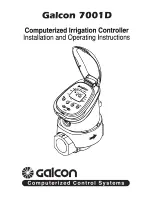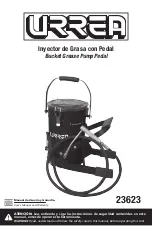
Installation, Operation and Maintenance Manual
Installation, Operation and Maintenance Manual
4
1. Determine System Location (see Figures 1 and 2)
The Drinking Water Filtration System can be located under a sink or in a basement depending on space avail-
ability and preference. If a basement installation is selected, additional tubing, hardware and fittings may be
needed and a hole will have to be made from inside the cabinet, through the floor, to the basement.
Space Requirements
NOTE: Never install the filtration system in an area of the home
where the temperature may drop to freezing as damage to the
system will result.
The exact placement of the various components of the filtration
system will vary from installation to installation. The installer must
decide on where to place the faucet, tank and purification assembly
by balancing convenience with ease of installation and servicing.
Considerations for an icemaker or other remote hookup should be predetermined, including plumbing rout-
ing and any additional tools, fittings and tubing that may be required.
Feedwater Conditions
Parameter
pH
4-11
Manganese
< 0.05 ppm (mg/L)
Hardness
< 350 ppm (mg/L)
Hydrogen Sulfide
None allowable
Iron (FE)
< 0.3 ppm (mg/L)
Organics
< 1 ppm (mg/L)
Free Chlorine
Up to 3 ppm (mg/L)
Temperature
40-100°F (4-38°C)
Turbidity
< 1 NTU
TDS
Up to 2,000 ppm
Min./Max. Feedwater pressure 40-100 psi (276-690 kPa)
2. Prepare the Area for Installation
Determine where components will be located and how they will be mounted. Special mounting brackets
and hardware may be necessary to secure the system to a wall or ceiling joists if a basement installation is
called for. Inspect the cold water supply line and drain to determine if any additional fittings are required.
NOTE: It is a good idea at this time to check the condition of the undercounter plumbing for any existing or
potential leaks.
3. Prepare the Drinking Water Filtration System for Installation
Open the shipping carton and remove components. Check that all of the installation parts are present which
include the reverse osmosis (RO) assembly, storage tank, faucet, installation hardware, and tubing located
in box under storage tank.
If an optional percent rejection monitor is used, the probes should be installed at this time. Follow the in-
structions that come with the monitor.
14 5/8" NOM
6 1/2"
14 1/8" NOM
1 1/2"
Minimum Distance
Required To Remove
Cartridges
To reduce the risk associated with property damage due to
water leakage:
•
Protect from freezing. Drain filter when temperatures drop below
40°F (4.4°C).
•
Do not install if water pressure exceeds 125 psi (862 kPa). If
your water pressure exceeds 125 psi, you
must install a pres-
sure limiting valve. Contact a plumbing professional if you are
uncertain how to check your water pressure.
CAUTION
5
4. Install the Feed Water Valve and Tubing (see Figure 3)
The feed water saddle valve is designed for use with 3/8” to 1/2” OD soft copper tubing (plain or chromed) and
rigid metal pipe. Do not use with flexible ribbed supply tubing or plastic pipe which require special hardware.
Soft Copper Tubing Installations:
A) Turn off cold water valve under the sink, or the main water supply valve for the house.
B) Before installing feed water saddle valve, make sure piercing lance does not protrude beyond rubber
gasket. See instructions on bag.
C) Assemble both halves of feed water saddle valve on copper tubing.
D) For 3/8” O.D. tubing, use bracket with side projections to prevent distortion of tubing. Use “V” side of bracket for
all larger size tubing. Tighten screws evenly and firmly — brackets should be parallel. Do not deform tubing.
E) To pierce soft copper tube, turn handle to the right until it is firmly seated. The valve is closed in this position.
F) Turn on main supply valve to pressurize cold water line. Check for leaks. If valve stem leaks, tighten
nut/seal with a wrench.
G) Connect length of orange 1/4” tubing to feed water valve, using brass compression nut, insert and plas-
tic sleeve (refer to Figure 3).
Rigid Metal Pipe Installations:
A) Turn off cold water supply valve and drain the line to prevent spillage.
B) Drill 3/16” hole at the desired location. To prevent shock hazard, use a battery operated drill.
C) Turn valve handle to the right to expose piercing lance beyond the rubber gasket no more than 3/16”.
D) Assemble saddle valve on the supply pipe by screwing the two halves together. Use the “V” side of the
bracket. Tighten screws evenly and firmly, keeping the two sides of the bracket parallel.
E) Turn saddle valve handle to the right to close valve. If valve stem leaks, tighten nut/seal around valve
stem, with a wrench.
F) Connect length of 1/4” orange tubing to the feed water valve, using brass compression nut, insert and
plastic sleeve (refer to Figure 3).
NOTE: For basement installations, a longer length of orange feed water tubing may have to be used.
5. Prefill and Sanitize the Storage Tank
Prefilling the tank is always recommended so there is pressure to check for leaks and water to flush the
carbon filters. Tanks are furnished with a special disinfection capsule which sanitizes the tank when it is
filled with water. It is important to use a sanitizer when prefilling tank so the solution can sanitize the tubing,
fittings and faucet at the time of installation and startup.
A) Place tank on stand.
B) Remove the soft rubber cap from the tank inlet fitting.
C) Wrap PTFE tape to the right (clockwise) onto threads.
D) Pour sanitizer into tank.
WARNING
To reduce the risk associated with eye, skin and respiratory and digestive tract burns from Calcium Hypo-
chlorite during installation:
• Calcium Hypochlorite (CAS 7778-54-3) granules are used for tank sanitation in this product.
• During installation, do not get in eyes or on skin or clothing. Do not ingest. Wear eye and face protection.
Keep
out of reach of children.
• For further safety information, refer to MSDS documents available at CHEMTREC (1-800-262-8200) or www.3M.com.
• Some state and local plumbing codes may prohibit the use of saddle-type valves and/or drain connections. See
page 2 for list of states. Optional feed valve assemblies can be purchased. See page 15 for further information.
IMPORTANT NOTES





























